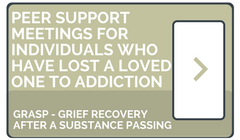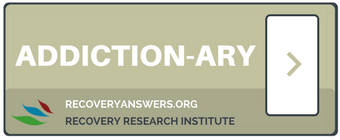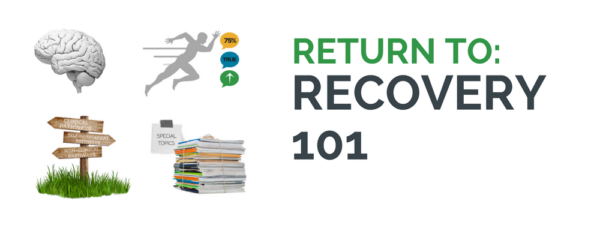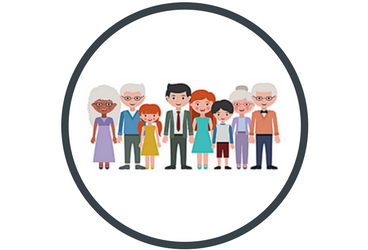
Guide for Family Members
Addiction affects the whole family. Loved ones, such as family members and friends, often need to seek out support services as well.
At least 25% of the population belongs to a family affected by an addiction disorder in a first-degree relative. According to the Federal Reserve’s annual report on the economic well-being of U.S. households, one in 5 Americans now know someone personally who has suffered from opioid addiction, and at least 25% of the population belongs to a family affected by a substance use disorder in a first-degree relative. The data also suggest that up to 90% of individuals with active addiction live at home with a family or significant other.
Addiction is often referred to as a “family disease” to highlight the impact that substance use disorder can have, and the interrelated nature of, substance use within family units. Family members are often in a position to assist in diagnosis or problem identification, and can play an important role in encouraging substance use treatment and recovery.
FAMILY MEMBER-SPECIFIC SENSITIVITIES:
- STIGMA
-
Substance use disorder is one of the most stigmatized health conditions in the world, and family members often also experience feelings of guilt, embarrassment, and shame related to a loved ones substance use.
Family members may not want to, or feel that they are unable to share their experiences with others. Family members may isolate themselves as a defense to shame.
Stigma is a known barrier to treatment seeking, and can stop family members from seeking outside support, or individual treatment for themselves, or their loved ones.
- CONCURRENT ISSUES
-
Issues found to be characteristic of families affected by substance use disorder include:
- financial difficulties
- joblessness
- marital problems (unhappy marriages and divorce)
- shifting family roles
- increased exposure to illness
- domestic violence
- child abuse or neglect
- academic problems in children
- inconsistent childcare
- social isolation
- exposure to crime or criminal activity
Substance use disorders overwhelmingly correlate with familial, environmental, and genetic factors, and heavily cluster in certain families; therefore, diagnosis of addiction in an individual, may indicate larger family histories of substance use disorder, and increases the risk for earlier experimentation with alcohol and other drugs in adolescents.
- EMOTIONAL FACTORS
-
Addiction can have a significant emotional toll on not only the individual suffering, but the entire family unit. The emotional reactions and experiences of affected family members will often vary widely, and also change over time. Commonly reported emotions from affected family members include feelings of abandonment, anxiety, fear, anger, concern, embarrassment or guilt.
In response to a loved ones addiction, family members will sometimes employ defense mechanisms as a means of emotional coping. Common defense mechanisms include:
- Denial that there is a problem
- Isolation as a defense to shame
- Minimization of the magnitude of the problem
- Projection of the problem (e.g. blaming others)
- Rationalization or making excuses
Stages of Coping When a Loved One Has a Substance Use Disorder
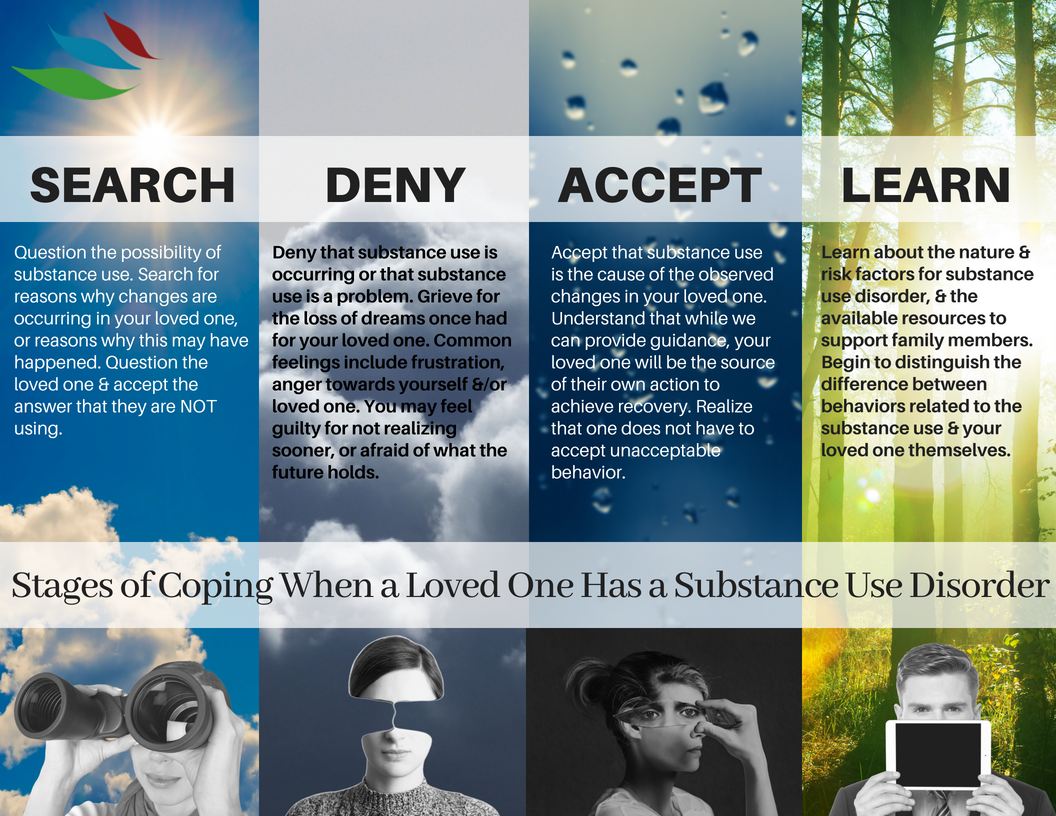
SUPPORTIVE MEASURES FOR FAMILY MEMBERS:
- PEER SUPPORT
-
Systematically linking family members of someone suffering from a substance use disorder to family-focused mutual help organizations has been found to reduces stress and perceived problems.
Participation in peer support groups is associated with positive outcomes, such as improved physical and mental health, substance use, personal functioning (e.g., coping, self-esteem, social functioning), well-being and quality of life, and function within couple/family relationships, gains in understanding of and coping with addiction, feeling better able to help and communicate with their loved-one, and reductions in self-blame and stress.
What makes mutual help or peer support groups effective? Active ingredients of mutual help groups include:
- bonding, goal direction, and structure
- provision of norms and role models
- involvement in rewarding activities
- bolstering self-efficacy and coping skills
EXAMPLES OF PEER SUPPORT GROUPS FOR FAMILY’S AFFECTED BY A LOVED ONES ADDICTION:
Al-Anon: Al-Anon is a group for people who have been affected by a loved one’s alcohol use disorder. Groups are based on 12-step principles and have attendees share stories and build supportive networks to help cope with the difficulties of having a loved one with an alcohol use disorder.
Alateen: Alateen is part of Al-Anon specifically designed for adolescents and young people affected by the alcohol use disorder of a loved one.
Nar-Anon: Similar to Al-Anon, but rather than focusing exclusively on alcohol use disorders, this group is for anyone with a loved one with an addiction to any substance. The principles of the group are based in 12-step ideology and attendees share stories as a way of finding strength to support their loved one and encourage them to follow a path to recovery.
SMART Recovery Family & Friends: A science-based alternative for those affected by the substance use of a loved one. The program is based on the tools of SMART Recovery and CRAFT (Community Reinforcement Approach & Family Training). Online meetings are available as well as a growing number of community meetings.
Learn To Cope: Learn to Cope is a non-profit support network that offers education, resources, peer support and hope for parents and family members coping with a loved one addicted to opiates or other drugs.
- INDIVIDUAL THERAPY
-
Parents of a loved one suffering from a substance use disorder may seek out individual therapy or counseling. Research has shown that parents benefit from treatment geared toward their own coping and well-being.
- TRAINING & EDUCATION
-
EDUCATION
Education and training can empower family members in their own lives, and help them support treatment and recovery engagement in a loved one. It is important that trusted and accurate information be available and accessible for this purpose.
Important education topics for family members include everything from the nature of substance use disorder and risk factors, to high quality treatment indicators and options, to learning about boundary setting, self-care, and identifying stigma.
Sign up for the Recovery Research Institute Recovery Bulletin to get the latest research in addiction treatment and recovery.
LEARN ADDICTION TERMINOLOGY
Language matters, especially when a condition is as stigmatized as substance use disorder. The Addictionary is a glossary that can help family members identify stigmatizing words and offer alternative non-stigmatizing language.
NARCAN TRAINING
By receiving training in administering the FDA approved opioid overdose reversal medication Narcan® (Naloxone), families can be better equipped to prevent the death of a loved one.
SEE INFOGRAPHIC: Identifying a Drug Overdose
READ MORE: Overdose-Reversal Medication (Narcan®) Guide
- SELF-CARE
-
It is important that self-care be emphasized among affected family members. Helping oneself, allows you to be in a position to be able to help others. Without adequate self-care, personal resources can run low leading to mental and emotional turmoil, resentment, hostility, exhaustion, and eventually burnout.
SELF-CARE ACTIVITIES CAN BE PLACED INTO 5 MAIN CATEGORIES:
- SENSORY: Activities that draw one into the present moment through any of the five senses.
- smelling a scented candle
- holding an animal
- EMOTIONAL: Activities that allow one to work through both negative and positive emotions constructively.
- journaling
- individual therapy or counseling session
- PHYSICAL: Activities that engage and exert the physical body to release energy and stress.
- walking in the woods
- attending a yoga class
- SPIRITUAL: Activities that get one in touch with core values and a deeper sense of what really matters.
- meditating
- attending a religious service
- SOCIAL: Activities that allow one to connect with others and maintain a sense of shared human experience.
- spending time with close friends
- attending an event outside the home
- SENSORY: Activities that draw one into the present moment through any of the five senses.

MEASURES TO SUPPORT A LOVED ONE WITH SUBSTANCE USE DISORDER:
SEE INFOGRAPHIC: 8 WAYS TO HELP YOU KEEP LOVING SOMEONE WITH AN ADDICTION- BOUNDARY SETTING
-
Boundaries are rules that set limits on what is and is not acceptable in any given relationship. Boundaries create clear expectations for behavior that can work to protect family members from substance-induced harms and support recovery.
Examples of boundaries:
- No alcohol or drugs allowed in the house
- No alcohol or drug related friends allowed in the house
- No borrowing the car, money, or cell phone under any circumstances
- LIMITING TRIGGERS
-
Family members can be a significant agent of support to a loved one in recovery by developing awareness of, and working to help manage potential environmental or social triggers.
Research has found that continued familial conflict or continued substance use by family members can increase rates of relapse in other family members working towards recovery. Employing strategies to positively solve conflicts, build familial harmony, and strengthen relationships can help facilitate long-term recovery.
TRIGGERS CAN BE CLASSIFIED INTO 3 MAIN CATEGORIES:
- Environmental triggers: people or places once associated with substance use
- Re-exposure triggers: exposure to alcohol or other drugs, especially the primary problem substance
- Stress triggers: strong emotions such as anger, fear, anxiety, or sadness
- FAMILY INTEGRATION & THERAPY
-
Research has shown that incorporating family members, family education, and family therapies into addiction treatment and recovery positively impacts both the patient and family members. Engaging significant others and loved ones in treatment increases the likelihood that the patient will stay in treatment and that treatment gains will be sustained after treatment has ended.
Available evidence suggests that integrated treatment programs for mothers and their children are linked to:
- Improvements in parenting skills, which are shown to improvethe prognosis and outcomes for both mothers and their children.
- Increased motivation to abstain from drug and alcohol use.
- Improvements for children in development, growth, emotional and behavioral functioning,in contrast to infants whose mothers were not enrolled in an integrative program.
FAMILY ORIENTED TREATMENTS:
Family Therapy: Family therapy is a branch of psychotherapy that focuses on family‐level assessment to address the interdependent nature of familiar relations and transform these complex relational patterns to promote long-term recovery.
Family therapy for substance use disorder draws on the family’s strengths and resources to develop constructive strategies through the clarification of family roles, re-framing of behavior, teaching of management and coping skills, encouraging monitoring and boundary setting, creating re-intervention plans, and connecting families to additional resources. READ MORE…
Motivational Interviewing: Motivational Interviewing is a counseling approach designed to help individuals resolve ambivalence about their alcohol and/or drug use, and support efforts to change it. READ MORE…
Community Reinforcement and Family Training (CRAFT): The Community Reinforcement Approach (CRA) is a psychosocial intervention for individuals with alcohol and other drug use disorders that has been adapted for several populations, including family members of individuals resistant or reluctant to enter treatment (Community Reinforcement and Family Training; CRAFT). CRAFT is used to train concerned significant others to positively reinforce abstinence, reduced substance use, and recovery behaviors. READ MORE….
- INTERVENTION
-
Interventions to address substance use disorder vary widely in format and style, but often share a common desire of seeing a loved one enter into addiction treatment.
Traditional Approach
This approach, sometimes referred to also as the Johnson Intervention, has been recently popularized with mainstream shows such as “Intervention,” but is known to be less effective than other strategies. It involves loved ones holding a meeting to lovingly but firmly communicate with the individual about their substance use, in an attempt to improve the situation and compel their loved one to seek treatment. The intervention uses the contingencies provided by closely affected loved-ones to address issues of denial, express the impact of the substance use on them and others, encourage treatment seeking, and outline consequences in the absence of treatment seeking. Loved ones are strongly advised to seek the assistance of a mental health professional to facilitate an intervention of this kind.
Motivational Approach
This approach, uses encouragement and motivation to inspire a family member suffering from substance use disorder to seek out addiction treatment themselves. This approach, known as CRAFT (Community Reinforcement Approach and Family Training) was found to be 2x more effective than the Johnson Intervention and 3x more effective than Al-Anon/Nar-Anon Facilitation, a 12-step mutual-help approach. In controlled studies conducted primarily with parents and spouses of adults with substance use disorder, CRAFT has consistently produced higher rates of treatment entry for the person of concern (the loved one suffering from addiction). In the CRAFT approach, a therapist will work with the family or concerned loved ones to practice self-care, create an environment that promotes abstinence, and prepare a treatment and recovery plan in preparation for a time when the loved one is ready to pursue treatment and recovery.
- CIVIL COMMITMENT
-
More than 35 states in the U.S. have civil commitment laws in place, that allow family members or healthcare providers to petition the court, to involuntarily send an individual with severe substance use disorder to inpatient addiction treatment to prevent serious harm.
The evidence for civil commitment is mixed at best. Little research exists on the long-term outcomes of individuals who have been involuntarily committed. While there is a larger body of research available on the effectiveness of coerced or compulsory treatment in criminal justice populations, findings have been inconsistent. Two systematic literature reviews conducted on the topic found that research on mandated treatment has been fraught with methodological problems.
Despite mixed evidence, the National Institute on Drug Abuse (NIDA) reports that individuals involuntarily coerced into addiction treatment stay in treatment longer and have similar outcomes compared to peers without legal involvement.
An important note to remember is that the effectiveness of addiction treatment involves a multitude of factors. Along with factors of motivation or desire to attend, effectiveness is also a function of condition severity, number of prior treatment episodes, age, presence of co-occuring mental illness, length of stay, therapeutic alliance, use of evidence-based interventions and assertive linkage to long-term continuing care (among other factors).
Regardless of voluntary or involuntary treatment attendance, substance use disorder necessitates a system of care that acknowledges the complexity and long-term chronic, relapsing nature of the disorder.
FINDING TREATMENT
READ MORE: Addiction Treatment (Rehab) Guide READ MORE: The 11 Indicators of Effective Addiction Treatment
MORE INFOGRAPHIC GUIDES
CITATIONS
- SOURCES
-
- Arria, A. M., & McLellan, A. T. (2012). Evolution of concept, but not action, in addiction treatment. Substance Use and Misuse, 47, 1041-1048.
- Bright, D.A., & Martire, K.A. (2013). Does coerced treatment of substance-using offenders lead to improvements in substance use and recidivism? A review of the treatment efficacy literature. Australian Psychologist. 48(1), 69-81.
- Donovan, D. M., Ingalsbe, M. H., Benbow, J., & Daley, D. C. (2013). 12-Step Interventions and Mutual Support Programs for Substance Use Disorders: An Overview. Social Work in Public Health, 28(0), 313–332. http://doi.org/10.1080/19371918.2013.774663
- Fichter, M. M., Glynn, S. M., Weyerer, S., Liberman, R. P., & FRICK, U. (1997). Family climate and expressed emotion in the course of alcoholism. Family Process, 36(2), 203-221.
- Kelly, J. F., Fallah-Sohy, N., Cristello, J., & Bergman, B. (2017). Coping with the enduring unpredictability of opioid addiction: An investigation of a novel family-focused peer-support organization. Journal of substance abuse treatment, 77, 193-200.
- Kirby, K. C., Versek, B., Kerwin, M. E., Meyers, K., Benishek, L. A., Bresani, E., … Meyers, R. J. (2015). Developing Community Reinforcement and Family Training (CRAFT) for Parents of Treatment-Resistant Adolescents. Journal of Child & Adolescent Substance Abuse, 24(3), 155–165. http://doi.org/10.1080/1067828X.2013.777379
- Klag, S., O’Callaghan, F., & Creed, P. (2005). The use of legal coercion in the treatment of substance abusers: An overview and critical analysis of thirty years of research. Substance Use and Misuse, 40(12), 1777-1795.
- Liepman, M. R., Gross, K. A., Lagos, M. M., Parran, T. V., & Farkas, K. J. (2014). Family involvement in addiction, treatment, and recovery. In The ASAM Principles of Addiction Medicine: Fifth Edition. Wolters Kluwer Health Adis (ESP).
- Lussier, M.-T., & Richard, C. (2007). The motivational interview: In practice. Canadian Family Physician, 53(12), 2117–2118.
- McGillicuddy, N. B., Rychtarik, R. G., & Papandonatos, G. D. (2015). Skill training versus 12-step facilitation for parents of substance-abusing teens. Journal of substance abuse treatment, 50, 11-17.
- Moos, R. H. (2008). Active ingredients of substance use‐focused self‐help groups. Addiction, 103(3), 387-396.
- National Institute on Drug Abuse. (2012). Principles of drug addiction treatment: A research-based guide. Rockville, MD: National Institutes of Health.
- Ries, R. K., Fiellin, D. A., Miller, S. C., & Saitz, R. (2014). The ASAM principles of addiction medicine. Lippincott Williams & Wilkins.
- Roozen HG, de Waart R, van der Kroft P. Community reinforcement and family training: an effective option to engage treatment-resistant substance-abusing individuals in treatment. Addiction. 2010;105(10):1729-1738.
- Shrivastava, A., Johnston, M., & Bureau, Y. (2012). Stigma of Mental Illness-1: Clinical reflections. Mens Sana Monographs, 10(1), 70–84.
- Timko, C., Young, L. B., & Moos, R. H. (2012). Al-Anon family groups: Origins, conceptual basis, outcomes, and research opportunities. Journal of Groups in Addiction & Recovery, 7(2-4), 279-296.
- Timko, C., Laudet, A., & Moos, R. H. (2016). Al-Anon newcomers: Benefits of continuing attendance for six months. The American journal of drug and alcohol abuse, 42(4), 441-449.
- Treatment Improvement Protocol (TIP) Series, No. 39.; Chapter 2 Impact of Substance Abuse on Families. Center for Substance Abuse Treatment. Rockville (MD): Substance Abuse and Mental Health Services Administration (US); 2004.

